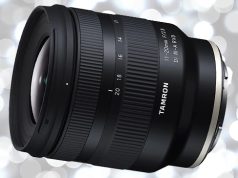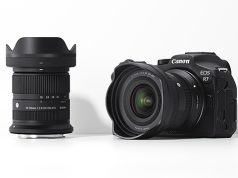
Over the past year or two we have witnessed a veritable explosion of new interchangeable-lens cameras aimed at everyone from entry-level up-graders to serious enthusiasts and pros—in formats ranging from Nikon’s CX format and the Micro Four Thirds system to APS-C, full-frame 24x36mm and medium formats.
In order to fulfill their mission, motivate consumers and stay on top of what has become a fiercely competitive market, camera and lens makers are offering enticing lenses as an effective and essential strategy. They have stepped up to the plate, unleashing an unprecedented barrage of new lenses designed to enhance the prestige and performance of their camera systems, increase or maintain their market share, bolster the corporate bottom line, strengthen marketing opportunities for dealers and, of course, expand shooters’ picture-taking horizons.
Some of the hottest categories of lenses relate directly to the increasing sophistication of interchangeable-lens camera buyers. Most are knowledgeable about the advantages of wide-aperture lenses in handheld available-light shooting and for creating professional-looking pictorial effects with shallow depth of field. Travelers and vacationers have a greater appreciation of the advantages of long-zoom ranges in enhancing optical flexibility and convenience. Nature and wildlife shooters understand that macro capability and image stabilization help in achieving crisp images, and serious enthusiasts and pros demand lenses that deliver the ultimate in image quality and are willing to pay premium prices to get it.
These are just some of the trends that are discernible among the latest crop of optics detailed here. While we couldn’t possibly include every new lens, we do hope this selected roundup of innovative optics gives you a good overview of this rapidly expanding sector.
A Compendium of Cool Lenses
Sony introduced five full-frame E-mount lenses and innovative mount adapters to complement its brand-new α7R and α7 full-frame mirrorless cameras, bringing the E-mount line to 22 lenses. The new lenses fit existing E-mount cameras, including the NEX-6 and NEX-7, and the LA-ER4 mount adapter adds compatibility for Sony A-mount cameras.
Carl Zeiss Vario-Tessar T* 24–70mm f/4. Featuring Optical SteadyShot image stabilization, this lens incorporates five aspheric elements plus one ED glass element for superior correction, as well as T* coatings to cut glare and internal reflections and boost contrast. $1,200.
Carl Zeiss Sonnar T* 35mm f/2.8. This compact, lightweight wide-angle prime lens is optimized for low-light shooting. It has dust- and moisture-resistant construction and T* coatings to increase light transmission and reduce glare. $800.
Carl Zeiss Sonnar T* 55mm f/1.8. A high-speed prime normal lens designed for pro-style background defocus effects and shooting in low light, it features a nine-blade circular diaphragm, dust and moisture resistance, and T* coatings to minimize glare. $1,000.
Sony 28–70mm f/3.5–5.6 OSS. This is a high-performance short zoom for general photography that is paired as a kit lens with the Sony α7 camera. Ideal for travel, it features Optical SteadyShot image stabilization, three aspherical elements and one ED glass element to minimize aberration and its weight, and dust- and moisture-resistant construction. $2,000 with the Sony Alpha α7 body.
Sony G 70–200mm f/4 OSS. This premium telephoto lens covers a wide zoom range and uses an innovative optical design with two ED class elements and three aspheric elements for minimal distortion and enhanced image quality. Other features include a circular aperture and built-in Optical SteadyShot. Price: TBA. sony.com
Sigma 24–105mm f/4 DG OS HSM Art. This full-frame lens is the newest addition to Sigma’s Art lens line. A versatile wide-to-medium-telephoto zoom, it has a constant aperture of f/4 and an inner focusing system that eliminates front lens rotation. And it incorporates Sigma’s proprietary Optical Stabilizer (OS) technology to compensate for camera shake. Other features include a minimum focusing distance of 17.7 inches, a maximum magnification ratio of 1:4.6, SLD and FLD high-performance glass elements for correction and enhanced image quality, a hypersonic motor (HSM) and full-time manual focus. The 19-element, 14-group lens has a minimum aperture of f/22. $899. sigmaphoto.com
Nikon 1 Nikkor AW 11–27mm f/3.5–5.6. This dedicated zoom lens for Nikon’s CX-format Nikon 1 AW 1 waterproof camera has a 30–74mm equivalent range, and it is lightweight, durable and provides a 2.5x zoom ratio. $145.95.
Also introduced was the 1 Nikkor AW 10mm f/2.8 wide-angle (27mm equivalent) lens, to provide two versatile lens options for Nikon’s everything-proof active lifestyle interchangeable-lens camera. The high-speed prime lens is capable of providing images with pleasantly defocused backgrounds at its widest apertures, even in challenging conditions, such as at dusk or underwater. $199.95. nikonusa.com
Olympus M.Zuiko Pro Series Lenses. Announced with the new flagship Olympus OM-D E-M1, two wide-aperture premium Micro Four Thirds-format lenses mark the debut of the M. Zuiko Pro lens category.
M.Zuiko Digital ED 12–40mm f/2.8 Pro. This 24–80mm equivalent lens employs weatherproof sealing, nearly silent autofocus during still and movie shooting and a constant f/2.8 aperture. It is claimed to deliver superior image quality over its entire range. $999.
M.Zuiko Digital ED 40–150mm f/2.8 Pro. A high-speed, constant aperture telephoto zoom (80–300mm equivalent), this lens is planned for release in the latter half of 2014. It will feature rugged, dustproof, splashproof construction designed to withstand the rigors of professional use. Pricing: TBA. olympusamerica.com
HD Pentax DA Limited Lenses from Ricoh Imaging. This series of high-performance DA prime lenses for Pentax K-mount DSLRs all feature wide apertures, robust construction and very high-quality finishes—and they are said to deliver pro-caliber image quality.
The HD Pentax DA 15mm f/4 ED AL Limited ($699.95), HD Pentax DA 21mm f/3.2 AL Limited ($699.95), HD Pentax DA 35mm f/2.8 Macro Limited ($749.95), HD Pentax DA 40mm f/2.8 Limited ($549.95), and HD Pentax DA 70mm f/2.4 Limited ($749.95) lenses feature advanced optical designs, super protect (SP) coating for improved light transmission and reduced flare and ghosting, and multilayer HD coatings for sharp, clear imagery. Their upgraded, rounded diaphragms deliver beautiful bokeh effects at wide aperture settings, and all five sport elegant, hand-machined aluminum bodies. They are available in silver or black finishes. us.ricoh-imaging.com
Leica Elmarit-S 45mm f/2.8 Asph CS. This new ultra-high-performance Leica Elmarit-S wide-angle lens rounds out the optical line for Leica S-system cameras—a system that combines medium-format image quality and 35mm SLR-like handling. The lens is said to deliver maximum contrast rendition, high resolution and extremely low distortion. It is built to maintain its high level of performance even under adverse lighting conditions, and it is sealed to resist dust and water spray for maximum dependability under harsh conditions. It employs a total of 12 elements in its construction, three made of specialized glass with anomalous partial dispersion, two low-dispersion elements, and one aspheric surface element to minimize aberrations and achieve an exceptional level of optical performance. $7,450. us.leica-camera.com
Panasonic Lumix G 20mm f/1.7 II Asph. This new high-speed semi-wide-angle “pancake” lens for Micro Four Thirds cameras is compact and lightweight despite its very wide aperture. It features a new metallic profile in the Micro Four Thirds standard, and its wide f/1.7 aperture enables striking pictorial effects that make the subject stand out against a soft background. Comprised of seven lenses in five groups, the 40mm-equivalent lens employs two aspheric elements to minimize chromatic aberration and distortion, and achieve high corner-to-corner resolution. Seven blades provide a rounded aperture to produce smooth bokeh at wide aperture settings, and multicoated lens elements minimize flare and ghosting. It’s available in black and silver. $429. panasonic.com
Zeiss Touit Compact System Camera Lenses. For the first time, Zeiss has entered the compact system camera lens market with two lenses available in Sony NEX and Fujifilm X mounts. Their features include metal bodies, aperture rings calibrated in 1/3 stops (Fujifilm version), nine-blade apertures for an almost circular diaphragm to provide natural and pleasing bokeh, and Zeiss T* coatings for maximum light transmission and minimum flare and ghosting.
Touit 12mm f/2.8. This wide-aperture 18mm-equivalent prime lens is said to be the most extreme wide-angle fixed focal length in the APS-C range. It has 11 elements in eight groups and is based on the Distagon formula with floating elements, three anomalous dispersion glass elements and two aspheric elements. $1,250.
Touit 32mm f/1.8. A fast-aperture normal (48mm equivalent) lens, it is ideal for low-light photography and limited depth-of-field applications. It offers an angular field that resembles natural eyesight, and it employs an updated Planar design consisting of eight elements. $900. zeiss.com
Fujifilm Fujinon XF23mm f/1.4 R. Designed for Fujifilm’s high-performance X-series compact system cameras, this ultra-fast 35mm-equivalent wide-angle lens allows users to shoot handheld in low light and to create striking pictorial (bokeh) effects with limited depth of field. Claimed to deliver enhanced resolving power, it utilizes an internal focusing system that incorporates a lens group consisting of three cemented elements and one aspheric element to keep weight down. It also uses a high-torque coreless DC motor for faster autofocus and employs high-transmittance electron beam coatings (HT-EBC) to ensure excellent light transmission and minimize flare and ghosting. A camera-to-subject distance indicator and a depth-of-field scale on the barrel are useful when manually prefocusing to capture fast-moving subjects or to minimize shutter lag. $899.95. fujifilmusa.com
Tamron AF 18–270mm f/3.5–6.3 Di II VC PZD. Incorporating the full complement of Tamron’s advanced long-range-zoom technology, this 15x, 28–419mm equivalent zoom for APS-C-format DSLRs incorporates an ultrasonic Piezo Drive (PZD) for fast, quiet, precise autofocus, Tamron’s proprietary VC (vibration compensation) image stabilization technology and three hybrid aspheric elements plus two low-dispersion elements for superior correction and enhanced image quality. Its cosmetics and control rings have also been upgraded to Di II specs. It focuses down to 19.3 inches at all focal lengths for a maximum reproduction ratio of 1:3.8 at 270mm. $449.
Tamron SP 90mm f/2.8 Di Macro 1:1 VC USD. Designed for both full-frame and APS-C-format DSLRs, this upgraded lens incorporates Tamron’s proprietary VC (vibration compensation) image stabilization system, a particularly important feature in a macro lens designed for handheld shooting at high magnification. The lens also employs an internal focusing system so that it does not change length or balance when focusing, and it offers precise manual focusing at any time. It can also do double duty as a wide-aperture portrait lens. Other features include an ultrasonic drive (USD), a nine-blade circular diaphragm for enhanced bokeh, moisture-resistant construction and Tamron’s eBand coating, claimed to deliver a dramatic improvement in antireflection performance. $749. tamron.com





